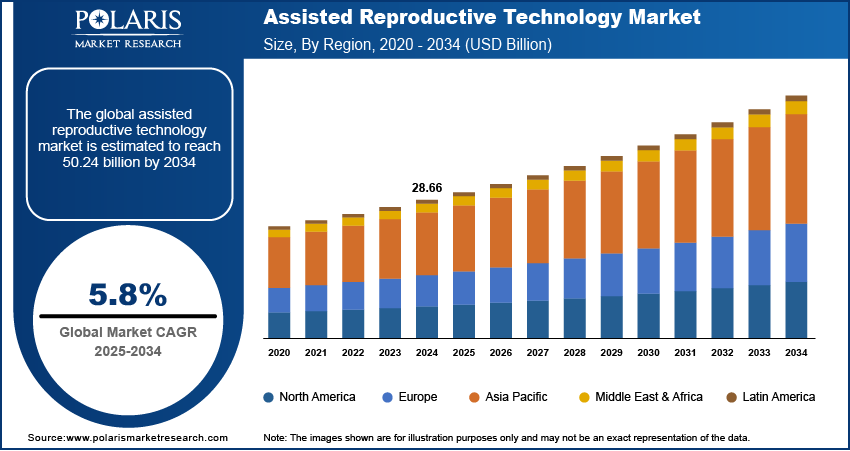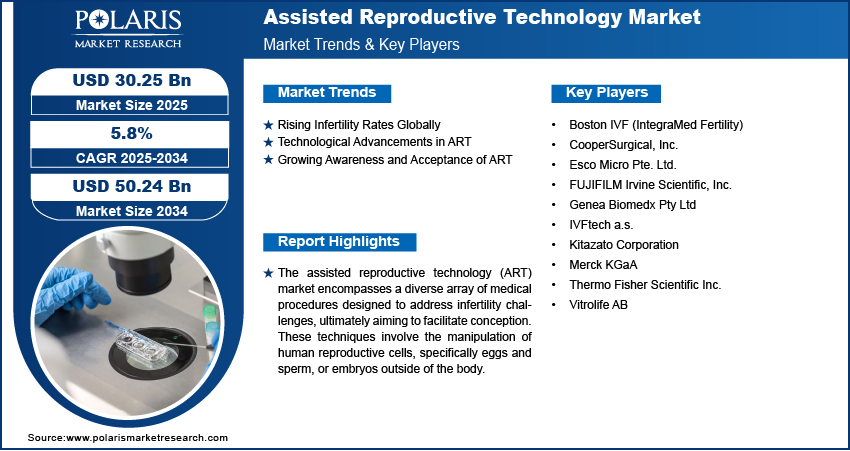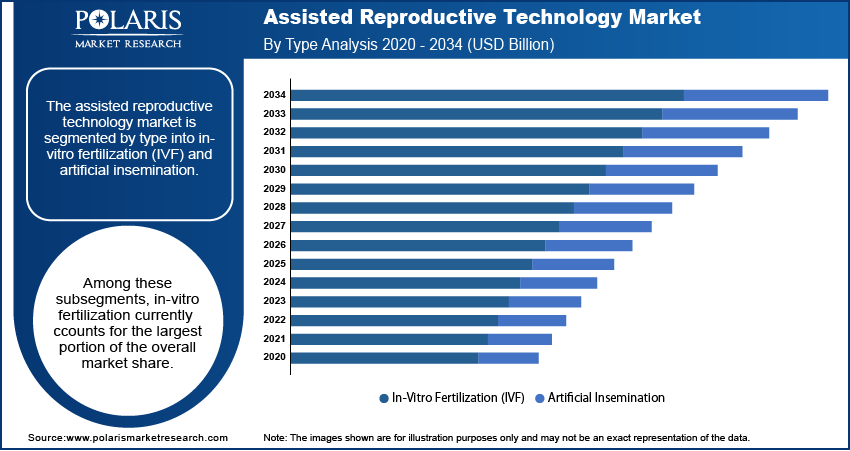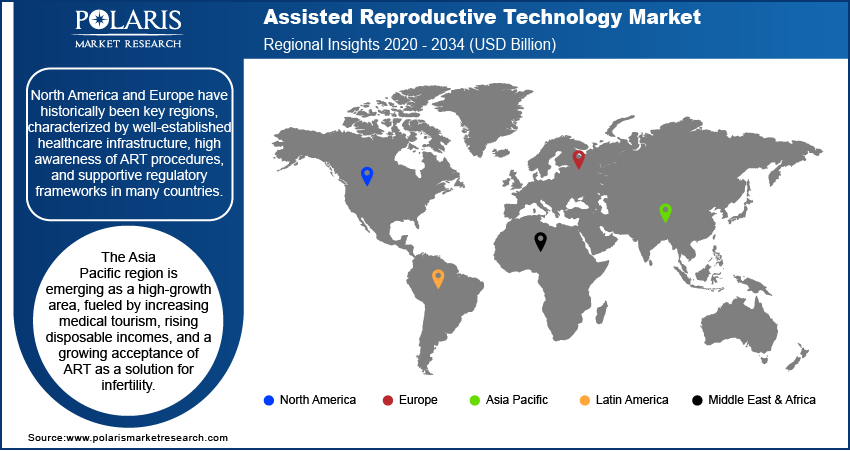
Assisted Reproductive Technology Market Size, Share, Trends, Industry Analysis Report
: By Type (In-Vitro Fertilization (IVF) and Artificial Insemination), End Use, and Region (North America, Europe, Asia Pacific, Latin America, and Middle East & Africa) – Market Forecast, 2025–2034
- Published Date:May-2025
- Pages: 120
- Format: PDF
- Report ID: PM5641
- Base Year: 2024
- Historical Data: 2020-2023
Assisted Reproductive Technology Market Overview:
The assisted reproductive technology market size was valued at USD 28.66 billion in 2024. The market is projected to grow from USD 30.25 billion in 2025 to USD 50.24 billion by 2034, exhibiting a CAGR of 5.8% during 2025–2034.
The assisted reproductive technology (ART) market encompasses medical procedures employed to address infertility challenges, involving the manipulation of eggs, sperm, or embryos to facilitate conception. This market addresses a significant market demand driven by various factors, including rising infertility rates globally, often linked to delayed childbearing, lifestyle changes, and increased awareness of available treatments. The market drive is also propelled by evolving social norms, including the growing acceptance of diverse family structures and increased accessibility for single individuals and same-sex couples seeking parenthood. Furthermore, continuous advancements in medical technologies within the ART field, such as improved In Vitro Fertilization (IVF) techniques, genetic screening of embryos (PGT), fertility tests, and sophisticated cryopreservation methods, contribute significantly to the market development and improved success rates, thereby fueling further market growth.

To Understand More About this Research: Request a Free Sample Report
Several market growth factors are shaping the market outlook for assisted reproductive technology. The increasing prevalence of infertility worldwide is a primary market drive, impacting a substantial portion of the adult population. This is further exacerbated by environmental factors and medical conditions affecting fertility. The rising awareness and acceptance of ART procedures as viable solutions for infertility are also boosting market demand trends. Moreover, government initiatives and supportive regulations in various regions, coupled with the expansion of fertility clinics and increasing healthcare expenditure, are creating a favorable environment for market penetration and overall market development.
Assisted Reproductive Technology Market Dynamics:
Rising Infertility Rates Globally
The escalating rates of infertility across the globe represent a significant market drive for the assisted reproductive technology market. Several factors contribute to this growing concern, including delayed childbearing as individuals prioritize education and careers, lifestyle choices such as poor diet and lack of exercise, and increasing exposure to environmental pollutants. Medical conditions like Polycystic Ovary Syndrome (PCOS), endometriosis, and sexually transmitted infections also play a crucial role in rising infertility. According to data released by the National Library of Medicine in December 2022, approximately 11% of women who had previously given birth were unable to conceive again, and 2% of women between the ages of 20 and 44 experienced primary infertility. This increasing prevalence of infertility directly correlates with a heightened market demand for effective solutions, positioning ART as a primary option for couples and individuals facing challenges in conceiving naturally.
Moreover, approximately 1 in 6 people of reproductive age worldwide experience infertility in their lifetime. The annual percentage increase in infertility prevalence over these three decades was about 0.5% for men and 0.7% for women. In 2021, there were 110.1 million prevalent cases of female infertility globally, a 21.9% increase since 1990. The global number of years lived with disability due to female infertility was 601,134 in 2021, a 33.1% increase since 1990. The sheer volume of individuals and couples seeking fertility treatments due to rising infertility rates acts as a strong market growth factor, propelling the expansion of the assisted reproductive technology market as more people explore and undergo ART procedures to fulfill their family aspirations.
Technological Advancements in ART
Continuous advancements in medical technologies within the realm of assisted reproductive technology are a critical market drive fueling its growth. Innovations such as Intracytoplasmic Sperm Injection (ICSI), Preimplantation Genetic Testing (PGT), and advanced embryo cryopreservation techniques, along with smart fertility tracker have significantly improved the success rates of ART procedures. ICSI, where a single sperm is directly injected into an egg, has revolutionized the treatment of male factor infertility, as highlighted in a narrative review of sperm selection technology for assisted reproduction techniques published on Pubmed in September 2024. PGT allows for the genetic screening of embryos before implantation, reducing the risk of transmitting hereditary diseases and improving the likelihood of successful pregnancies. The ongoing research and development in this field continue to yield more sophisticated and successful techniques, thereby increasing patient confidence and driving the market development of the assisted reproductive technology market by offering more effective and personalized treatment options.
Growing Awareness and Acceptance of ART
The increasing awareness and societal acceptance of assisted reproductive technology as a viable solution for infertility is a significant market drive. As conversations around fertility challenges become more open and less stigmatized, more individuals and couples are willing to explore ART options. The efforts of various organizations and patient advocacy groups in disseminating information about infertility causes and available treatments contribute significantly to this growing awareness. Moreover, the changing social landscape, including the rise in single-parent families and same-sex couples seeking parenthood, further propels the acceptance and market demand for ART procedures. According to a report on fertility care in low and middle-income countries published on PubMed Central in November 2024, social shifts, including an increase in single parents and the growing acceptance of ART as a means for same-sex couples and individuals to build families, are driving the demand for assisted reproductive technology services. This growing understanding and acceptance erode previous stigmas associated with infertility treatments, encouraging more people to seek ART interventions. Consequently, this increased willingness to consider and undergo ART procedures acts as a substantial market growth factor, contributing significantly to the expansion and positive market outlook of the assisted reproductive technology market.

Assisted Reproductive Technology Market Segment Insights:
Assisted Reproductive Technology Market Assessment – By Type
The assisted reproductive technology market is segmented by type into in-vitro fertilization (IVF) and artificial insemination. Among these subsegments, in-vitro fertilization currently accounts for the largest portion of the overall market share. This dominance can be attributed to its higher success rates in addressing a wider range of infertility issues compared to other ART procedures. IVF involves the fertilization of eggs outside the woman's body, followed by the transfer of the resulting embryos into the uterus. This comprehensive approach allows for greater control over the fertilization and early embryonic development processes, making it a preferred choice for couples facing complex infertility challenges, including severe male factor infertility, blocked fallopian tubes, and unexplained infertility.
While in-vitro fertilization holds the largest current market share, the artificial insemination subsegment is demonstrating the most significant growth rate within the assisted reproductive technology market. Artificial insemination, which involves the direct introduction of sperm into a woman's uterus, is a less invasive and often more cost-effective option for certain types of infertility, such as mild male factor infertility or cervical factor infertility. The increasing adoption of artificial insemination is driven by its relative simplicity and affordability, making it a more accessible initial treatment option for a wider demographic.
Assisted Reproductive Technology Market Evaluation– By End Use
The assisted reproductive technology market is segmented by end use into fertility clinics & other facilities, hospitals, and others. Among these, the fertility clinics & other facilities segment currently commands the largest share of the assisted reproductive technology market. This dominance is primarily due to the specialized nature of these facilities, which are dedicated solely to providing a comprehensive range of ART services. Fertility clinics often possess state-of-the-art equipment, highly specialized medical professionals including embryologists and reproductive endocrinologists, and a patient-centric environment tailored to the unique needs of individuals and couples undergoing fertility treatments.
The hospitals segment is exhibiting the highest growth rate within the assisted reproductive technology market. The increasing integration of ART services into hospital settings is driven by several factors, including the broader reach and accessibility of hospitals within communities. Hospitals often have established infrastructure, a large patient base, and the ability to offer integrated care, including access to other medical specialties that may be relevant to fertility treatment. Furthermore, the growing recognition of ART as an essential medical service is leading to increased investment in establishing or expanding fertility departments within hospitals.

Assisted Reproductive Technology Market– Regional Footprint
Referring to available industry reports, a broad overview of the regional landscape of the assisted reproductive technology market reveals a significant global presence with varying levels of market maturity and growth potential across different geographies. North America and Europe have historically been key regions, characterized by well-established healthcare infrastructure, high awareness of ART procedures, and supportive regulatory frameworks in many countries. The Asia Pacific region is emerging as a high-growth area, fueled by increasing medical tourism, rising disposable incomes, and a growing acceptance of ART as a solution for infertility. Latin America and the Middle East & Africa represent regions with considerable market potential, witnessing increasing adoption of ART services alongside developing healthcare systems and evolving social norms regarding fertility treatments.
Among the various regions analyzed in industry reports, North America currently holds the largest share of the assisted reproductive technology market. This dominant position can be attributed to a confluence of factors, including a high prevalence of infertility, well-established and sophisticated healthcare infrastructure with widespread availability of advanced ART clinics, and favorable reimbursement policies in some areas. Furthermore, a strong emphasis on research and development in reproductive technologies and a relatively high level of awareness and acceptance of ART procedures among the population contribute to the significant market size of North America. The presence of key market players and continuous technological advancements further solidify North America's leading position in the global assisted reproductive technology market.
However, the Asia Pacific region is identified as exhibiting the highest growth rate in the assisted reproductive technology market across various industry reports. This rapid expansion is driven by a multitude of factors, including a large population base with increasing infertility rates, rising disposable incomes enabling greater access to fertility treatments, and a growing number of advanced fertility clinics, particularly in countries like China, India, and Japan. Additionally, increasing medical tourism to the Asia Pacific region for cost-effective and high-quality ART procedures contributes significantly to the region's high growth trajectory. Evolving social norms and decreasing stigma associated with infertility treatments are also encouraging more individuals and couples in the Asia Pacific region to explore and undergo ART, making it the region with the most promising market potential and the highest rate of market development in the global assisted reproductive technology market.

Assisted Reproductive Technology Market – Key Players and Competitive Insights
The major players actively operating in the assisted reproductive technology market include FUJIFILM Irvine Scientific, Inc., (FUJIFILM Holdings Corporation), CooperSurgical, Inc., (The Cooper Companies, Inc.), Vitrolife AB, Merck KGaA, Thermo Fisher Scientific Inc., Esco Micro Pte. Ltd., Genea Biomedx Pty Ltd, IVFtech a.s., Kitazato Corporation, and Boston IVF (IntegraMed Fertility). These entities are engaged in the development, manufacturing, and distribution of a wide range of products and services essential for ART procedures, including culture media, cryopreservation solutions, sperm preparation products, IVF workstations, micromanipulation systems, and laboratory disposables.
The competitive landscape of the assisted reproductive technology market is characterized by the presence of both well-established global players and smaller, specialized companies. Competition is driven by factors such as product innovation, the efficacy and safety of ART consumables and equipment, pricing strategies, and the geographical reach of the companies. Key areas of focus for competitive advantage include the development of advanced culture media formulations, enhanced embryo selection technologies, and user-friendly laboratory equipment. Strategic collaborations, partnerships, and expansions into emerging markets are also common strategies employed by players to strengthen their market position and cater to the growing market demand for ART solutions. The market dynamics are further shaped by increasing regulatory scrutiny and the growing emphasis on personalized fertility supplements and treatments.
FUJIFILM Irvine Scientific, Inc., a subsidiary of FUJIFILM Holdings Corporation, is located in Santa Ana, California, USA. The company offers a comprehensive portfolio of cell culture media, reagents, and devices for various applications, including assisted reproductive technologies. Their offerings for the ART market encompass a wide range of IVF media for oocyte retrieval, fertilization, embryo culture, and cryopreservation, as well as specialized media for sperm preparation and handling.
Vitrolife AB is headquartered in Gothenburg, Sweden. The company develops, produces, and markets essential products for assisted reproductive technology. Their product range includes culture media, cryopreservation solutions, single-use consumables for IVF laboratories, and advanced workstations for embryo handling and incubation.
List of Key Companies in Assisted Reproductive Technology Market:
- Boston IVF (IntegraMed Fertility)
- CooperSurgical, Inc. (The Cooper Companies, Inc.)
- Esco Micro Pte. Ltd.
- FUJIFILM Irvine Scientific, Inc. (FUJIFILM Holdings Corporation)
- Genea Biomedx Pty Ltd
- IVFtech a.s.
- Kitazato Corporation
- Merck KGaA
- Thermo Fisher Scientific Inc.
- Vitrolife AB
Assisted Reproductive Technology Market Industry Developments
- January 2024: Ivy Fertility partnered with fertility specialty pharmacy SMP Pharmacy Solutions to improve the patient experience across its 13 fertility centers through a collaborative co-branding initiative. This strategic partnership aimed to enhance services, provide comprehensive patient support, and create mutual benefits by strengthening both companies' offerings and patient satisfaction.
- October 2023: Hamilton Thorne Ltd. acquired Gynetics Medical Products, N.V., and Gynetics Services B.V., a leading manufacturer of innovative, high-quality IVF devices in the global market. This acquisition significantly expanded Hamilton Thorne’s product portfolio, reinforcing its position and competitiveness within the IVF industry.
Assisted Reproductive Technology Market Segmentation
By Type Outlook (Revenue-USD Billion, 2020–2034)
- In-Vitro Fertilization (IVF)
- Artificial Insemination
By End Use Outlook (Revenue-USD Billion, 2020–2034)
- Fertility Clinics & other facilities
- Hospitals
- Others
By Regional Outlook (Revenue-USD Billion, 2020–2034)
- North America
- US
- Canada
- Europe
- Germany
- France
- UK
- Italy
- Spain
- Netherlands
- Russia
- Rest of Europe
- Asia-Pacific
- China
- Japan
- India
- Malaysia
- Suth Korea
- Indnesia
- Australia
- Vietnam
- Rest of Asia-Pacific
- Middle East & Africa
- Saudi Arabia
- UAE
- Israel
- Suth Africa
- Rest of Middle East & Africa
- Latin America
- Mexic
- Brazil
- Argentina
- Rest of Latin America
Assisted Reproductive Technology Market Report Scope:
|
Report Attributes |
Details |
|
Market Size Value in 2024 |
USD 28.66 billion |
|
Market Size Value in 2025 |
USD 30.25 billion |
|
Revenue Forecast by 2034 |
USD 50.24 billion |
|
CAGR |
5.8% from 2025 to 2034 |
|
Base Year |
2024 |
|
Historical Data |
2020–2023 |
|
Forecast Period |
2025–2034 |
|
Quantitative Units |
Revenue in USD billion and CAGR from 2025 to 2034 |
|
Report Coverage |
Revenue Forecast, Market Competitive Landscape, Growth Factors, and Industry Insights |
|
Segments Covered |
|
|
Regional Scope |
|
|
Competitive Landscape |
|
|
Report Format |
|
|
Customization |
Report customization as per your requirements with respect to countries, regions, and segmentation. |
How is the report valuable for an organization?
Workflow/Innovation Strategy
The assisted reproductive technology market has been segmented into detailed segments of type and end use. Moreover, the study provides the reader with a detailed understanding of the different segments at both the global and regional levels.
Market Entry Strategies
Growth and marketing strategies within the assisted reproductive technology market are multifaceted, focusing on increasing awareness, accessibility, and success rates. Key strategies include targeted digital marketing campaigns to reach potential patients, emphasizing the emotional and practical aspects of overcoming infertility. Collaborations with fertility clinics and healthcare providers to expand service reach and build trust are also crucial. Furthermore, highlighting technological advancements and improved treatment outcomes through educational content and patient testimonials can attract individuals seeking advanced solutions.
FAQ's
The assisted reproductive technology market size was valued at USD 28.66 billion in 2024 and is projected to grow to USD 50.24 billion by 2034.
The market is projected to register a CAGR of 5.8% during the forecast period, 2024-2034.
North America had the largest share of the market.
Key players in the assisted reproductive technology market include FUJIFILM Irvine Scientific, Inc., (FUJIFILM Holdings Corporation), CooperSurgical, Inc., (The Cooper Companies, Inc.), Vitrolife AB, Merck KGaA, Thermo Fisher Scientific Inc., Esco Micro Pte. Ltd., Genea Biomedx Pty Ltd, IVFtech a.s., Kitazato Corporation, and Boston IVF (IntegraMed Fertility).
The Fertility Clinics & other facilities segment accounted for the larger share of the market in 2024.
Following are some of the assisted reproductive technology market trends: ? Rising Infertility Rates: Globally, there's an increasing prevalence of infertility due to factors like delayed childbearing, lifestyle changes, and various medical conditions, driving the demand for ART services. ? Technological Advancements: Continuous innovations in ART technologies, such as improved IVF techniques (like ICSI), preimplantation genetic testing (PGT), time-lapse embryo monitoring, and advanced cryopreservation methods, are enhancing success rates and expanding treatment options. ? Growing Awareness and Acceptance: Increased public awareness and a shift in societal norms towards accepting ART as a viable solution for infertility are encouraging more individuals and couples to seek these treatments. The rise in single-parent families and same-sex couples also contributes to this trend.
assisted reproductive technology (ART) encompasses a range of medical procedures used to treat infertility. These techniques involve the manipulation of eggs and/or sperm outside the body to help achieve pregnancy. The most well-known type of ART is In Vitro Fertilization (IVF), where eggs are retrieved from a woman's ovaries and fertilized by sperm in a laboratory. The resulting embryos are then transferred back into the woman's uterus.
